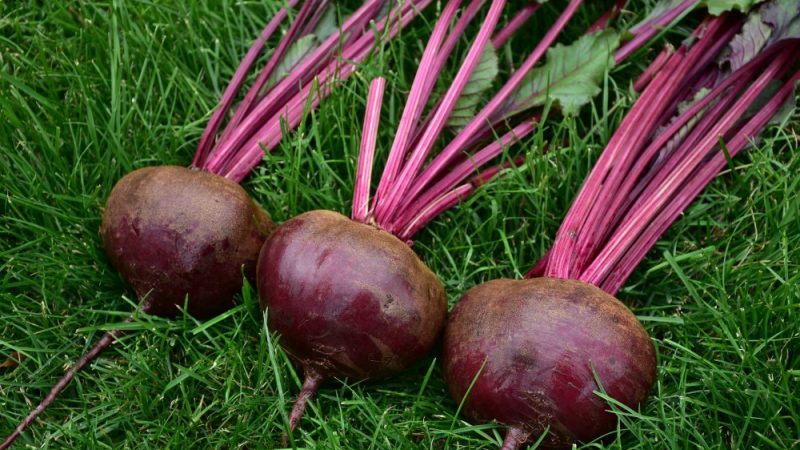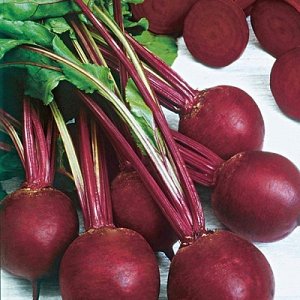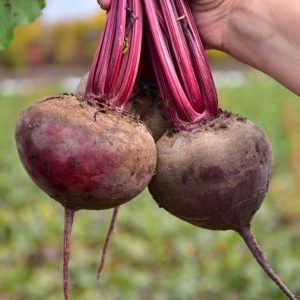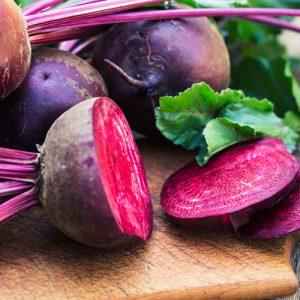How to grow a wonderful Kestrel beetroot hybrid correctly and how it differs from other species
Kestrel beetroot is the standard of beet varieties and hybrids. It is popular with gardeners around the world. Kestrel is appreciated for its taste and commercial qualities, unpretentiousness and stable yield. The vegetable is tasty and healthy, versatile in use.
Let us consider in detail what the f1 Kestrel beet is and how to grow a rich crop on your site.
The content of the article
Description
Kestrel belongs to mid-season crops, summer residents harvest 115-125 days after planting. In the southern regions of the country, these beets are planted with seeds in open ground, in the northern regions, seedlings are prepared.

Origin and development
The hybrid appeared thanks to the labors of foreign breeders. Initially, beets were grown in the USA and Europe, but over time, they won fame in Russia and neighboring countries - Ukraine, Kazakhstan, Moldova.
Distinctive features
The plant is small, the leaf rosette is compact. Kestrel is grown both for home use and on an industrial scale. The hybrid is resistant to weather changes and common diseases: root rot, powdery mildew, tobacco mosaic.
Fruit characteristics and yield
Fruits are spherical, smooth. The weight of one beet varies from 200 to 400 g. The tail is thin, the color is purple-pink. The pulp is firm, sugary and sweet. Kestrel has good keeping quality and can be transported over long distances. From 1 sq. m are harvested 6-8 large vegetables.
Interesting! 100 g of Kestrel beets contain 40 kcal. The vegetable is used for making juices and purees for children - the dishes are tender and healthy. Beets contain dietary fiber, amino acids, vitamins and minerals. Vitamins A and B help digestion, magnesium and calcium strengthen bones.
How to grow
Some gardeners plant Kestrel with seeds in open ground, while others prepare seedlings. Let's consider each method in detail.
Planting with seeds

Hybrid seeds are purchased in specialized stores... When buying, check the integrity of the packaging and the expiration date. The seeds are disinfected with aloe juice or succinic acid solution, soaked in liquid for a day. Then germinate - placed in wet gauze for a week. Disinfection and germination protect future plants from disease and insect pests.
Kestrel is planted in mid-May. Beforehand, the soil is dug up, cleared of weeds and debris. If the soil is acidic, lime it is sprinkled with a mixture of dry lime and wood ash. The beet planting scheme is 40 × 40, the sowing depth is 2 cm. The seeds are placed in wet holes and sprinkled with soil.
The plantings are watered with warm water and covered with a film that protects the seedlings from wind and rain. The film is removed after 7 days.
Seedling method
Seedlings are prepared at the end of March. For this, the disinfected seeds are placed in seedling containers - pots, cassettes or containers. Peat pots are convenient to use. They are made from environmentally friendly material, lightweight and affordable. When transplanting, the pots are moved to prepared beds and sprinkled with soil.
Important! Kestrel loves nutritious and loose soils. For seedlings, it is recommended to use ready-made mixtures "Biogrunt" or "Krepysh". They are disinfected by the manufacturer and are saturated with nutrients - magnesium, iron and potassium.
Seedlings need constant care: they are watered, loosened and fertilized. Moisten the beets as the soil dries, about once every 4–6 days. An excess of water will harm the plants, so they are watered carefully, from a pipette right under the root.It is prohibited to use cold tap water - seedlings can get sick.
Seedlings are fertilized once every 15 days with organic matter - manure, droppings, ash - and mineral dressings - superphosphate, ammonium nitrate, potassium salt.
Important! Before watering, the soil is loosened with a fork or pencil. Loosening depth - no more than 5 cm.
Care
To obtain a rich harvest, regular maintenance of beets is required. It consists of the following procedures:
- Watering, the frequency of which depends on the weather. In hot and rainy summers - every 7 days, in dry and cloudy - once every 5 days. Before watering the water is heated in the sun. About 0.8 liters are consumed per bush.

- Weeding involves loosening and removing weeds. Loosening makes the soil light, removing weeds maintains a healthy microflora in the beds and prevents pests.
- Mulching is a process in which the earth around the stem is sprinkled with sand, sawdust, foliage, shavings. Mulch nourishes the root system and protects it from hypothermia.
- Kestrel beets are fed 3-4 times. Organic and mineral fertilizers, root and foliar feeding (spraying from a spray bottle) are alternated.
- Thinning the beds maintains planting density. Thin the beets 2-3 times per season.
Important! Salt dressing has a positive effect on the quality of beets. For this, 60 g of table salt is diluted in 10 liters of pure water. It is recommended to water the beets with such a solution in June, during the formation of root crops.
Features of cultivation and possible difficulties
For accelerated development, in mid-June, after thinning, nitrogen fertilization is applied: 1 tablespoon of urea is diluted in 10 liters of water and the beds are watered. After the procedure, the beds are loosened and weeded, sprinkled with soil crumbs. The next fertilization is applied after 15 days. It should be remembered that an overabundance of nitrogen-containing substances will lead to an increase in green mass and the appearance of diseases.
Important! The best predecessors for table beets are carrots, herbs, garlic, legumes. It is not recommended to plant Kestrel after cabbage, radish, potatoes or radish. In the same place, the culture is planted no more than three seasons in a row.
Diseases and pests
The Kestrel hybrid is resistant to disease, however, due to improper care in the beds, the following diseases may appear:
- Ascochitis. The leaves are covered with brown spots, deep sores appear. Ascochitis occurs due to irregular watering and sudden changes in temperature. Disease prevention is the observance of care measures. For treatment use professional drugs "Maxim", "Quadris", "Oksikhom". Before use, study the recommendations and dosage.
- Fomoz covers the plant yellow spots... The causes of the disease lie in contaminated soil and non-compliance with the rules of crop rotation. If the disease is not detected in time, the plant will dry out and the fruits will deteriorate. Fomoz is treated with Bordeaux liquid or copper sulfate solution.
Of the insects, gardeners note the wireworm. The fat worm breaks holes in the ground and destroys the root system. The wireworm is dangerous for both young seedlings and large bushes. Insect prevention - dry eggshells in the beds.
Found in beet beds and slugs. Sticky pests suck the juice out of the leaves, causing the plants to wither soon. Get rid of slugs by spraying with iodine solution.
Harvesting and application of the crop
Harvest in September. The ripeness of the vegetable is determined by color and foliage. Ripe beets should be purple, with a lush rosette and well-visible veins. The lower leaves dry out, growths appear on the root crop.The vegetables are dug up with a shovel, cleaned from the ground and laid out on the beds to dry. After the tops are removed and stored.
Important! Store beets in a dry cellar or basement with an air humidity of no more than 85%. The vegetables are placed in clean wooden boxes and covered with newspapers. Stocks are periodically inspected for rot or insects. The spoiled fruit is thrown away.
Beets are used in the preparation of many dishes - vinaigrette, beetroot, borscht, salad with prunes. The vegetable gives the dishes a sweetish taste, saturates with vitamins and minerals. Prepared from beets and harvesting for the winter - pickled and canning harvest in the form of salads and snacks. To taste, beets are combined with cabbage, carrots, potatoes, pickles.
Interesting! In Russia, beets were used as a blush for the cheeks.
Advantages and disadvantages
The hybrid is appreciated for its unpretentiousness and high yield, tasty pulp and long shelf life. Kestrel is versatile in use, it is grown for home consumption and sale. The vegetable is famous for its attractive appearance, keeping quality and transportability.
The hybrid has no significant drawbacks. However, with improper care, Kestrel falls ill or dies from insect pests.
Farmers reviews
Despite the popularity of the Kestrel beet, there are negative reviews about this culture. Consider several opinions of experienced gardeners.
Galina, St. Petersburg: “I have been growing Kestrel for the third season in a row. Beets are tasty and juicy, they do not require a lot of water. I feed the plants with liquid mullein - it strengthens the roots and leaves. I pick vegetables in mid-September. "
Gennady, Ufa: “The hybrid is resistant to diseases, the yield is stable. The only negative is that you often have to weed and thin out the beds. This is not always convenient, you have to go to the garden every 3-4 days. I rate Kestrel on a solid four. "
Dmitry, Sochi: "Kestrel beets disappointed me. Obeyed all the rules of planting and care, prepared seedlings in advance. But due to frequent rains, the plants fell ill with ascochitis. Half of the harvest was lost. "
Conclusion
Kestrel is a versatile hybrid. It is planted by both experienced farmers and novice gardeners. The unpretentious crop shows the best yields on sunny and spacious beds fertilized with mullein.
Kestrel is harvested in September when the fruits are firm. Part of the crop is processed, the rest is harvested for long-term storage in the cellar.